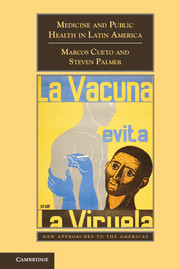Book contents
- Frontmatter
- Contents
- Acknowledgments
- Introduction
- Chapter One Indigenous Medicine, Official Health, Medical Pluralism
- Chapter Two National Medicines and Sanitarian States
- Chapter Three Making National and International Health
- Chapter Four Medical Innovation in the Twentieth Century
- Chapter Five Primary Health Care, Neoliberal Response, and Global Health in Latin America
- Conclusion
- Suggested Readings
- Index
- References
Chapter One - Indigenous Medicine, Official Health, Medical Pluralism
Published online by Cambridge University Press: 05 December 2014
- Frontmatter
- Contents
- Acknowledgments
- Introduction
- Chapter One Indigenous Medicine, Official Health, Medical Pluralism
- Chapter Two National Medicines and Sanitarian States
- Chapter Three Making National and International Health
- Chapter Four Medical Innovation in the Twentieth Century
- Chapter Five Primary Health Care, Neoliberal Response, and Global Health in Latin America
- Conclusion
- Suggested Readings
- Index
- References
Summary
The foundations of Latin American and Caribbean medicine and health were laid over three-and-a-half centuries of complex interplay among what were initially three broadly distinct civilizations. One was the grand variety of indigenous American healing systems, many of which were dismembered by contact and conquest. A second was made up of elements brought from Africa by slaves, some of them specialized healers, and reinvented by a variety of Afro-descended practitioners in contact with both indigenous and European medicine. The third was medicine from the countries of the colonizers, both popular and official, transferred to the Americas and in its official guise refashioned as an important pillar of colonial rule and legitimation.
The history of this interplay provides cues and clues to understanding the way that medical pluralism exists and interacts with official health and healing in contemporary Latin America and the Caribbean. The new history of medicine, covering the period from just before indigenous contact with the Spanish and Portuguese at the end of the fifteenth century until most of Latin America’s revolutionary republics and Brazil’s autonomous empire had established a tenuous independence in the mid-nineteenth century, has also expanded our knowledge of local social history. Perhaps most surprisingly, it has increased our knowledge of political history in which official and popular healers often played transformative parts. The new history of medicine and health during these three-and-a-half centuries also provides a much better sense of the agency of local actors, including indigenous and Afro-descended ones, in the global circulation of medical materials, ideas, and practices. This is parallel to a new history of science that finds insufficient the unidirectionality and dichotomy implied in previous models that emphasized the notions of cultural diffusion, center-periphery, or scientific imperialism as frameworks of analysis. This novel history conceives the circulation of plants, people, and ideas as an asymmetric creative process, one where nations and savants from different nations negotiated power, interacted, and reconfigured knowledge.
- Type
- Chapter
- Information
- Medicine and Public Health in Latin AmericaA History, pp. 10 - 57Publisher: Cambridge University PressPrint publication year: 2014



